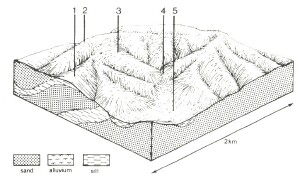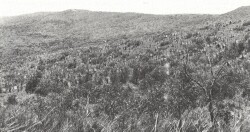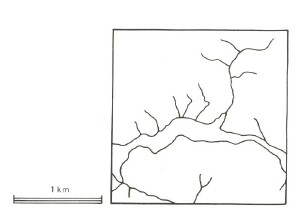Bald Hills Land System
Download the pdf version of this document: Bald Hills Land System (PDF - 846 KB)
To view the information, PDF requires the use of a PDF reader. This can be installed for free from the Adobe website (external link).
| Inland from Anglesea is a deeply dissected landscape with very stunted native vegetation, referred to as the Bald Hills. The Tertiary sediments exposed here include both sands and clays and are characterized by soils of extremely low fertility. Heaths and low woodlands are found on the upper parts of the landscape, where the sand soils tend to predominate. Xanthorrhoea australis is particularly common and tends to dominate on sites with hardpans developed in the soil profile. Lower down in the landscape, low forests or open forests of Eucalyptus nitida and E. obliqua tend to occur. Productive land uses are limited to the mining of sand and gravel in numerous shallow extraction pits, and mining of coal near Anglesea. Nature conservation and recreation are other forms of land use. |  |
in the understorey typify this land system, hardpan areas being demarcated by the absence of the tree stratum. |
|
Area: 92 km2 | Component and its proportion of land system | ||||
1 10% | 2 25% | 3 10% | 4 40% | 5 15% | |
| CLIMATE Rainfall, mm | Annual: 700 – 1,000, lowest January (35), highest August (100) | ||||
| Temperature, 0oC | Annual: 13, lowest July (8), highest February (18) | ||||
Temperature: less than 10oC (av.) mid June – mid August | |||||
Precipitation: less than potential evapotranspiration November - March | |||||
| GEOLOGY Age, lithology | Palaeocene unconsolidated quartz sand, gravel and clayey silt. | ||||
| TOPOGRAPHY Landscape | |||||
| Elevation, m | 0 – 210 | ||||
| Local relief, m | 90 | ||||
| Drainage pattern | Dendritic | ||||
| Drainage density, km/km2 | 2.1 | ||||
| Land form | Hill | Valley floor | |||
| Land form element | Upper slope, crest | Upper slope, crest | Broad, slightly depressed area of impeded drainage | Lower slop | - |
| Slope (and range), % | 7 (3-15) | 15 (2-35) | 7 (3-12) | 19 (10-35) | 1 (10-3) |
| Slope shape | Convex | Convex | Concave | Linear | Concave |
| NATIVE VEGETATION Structure | Low woodland | Low open woodland | Closed heath | Open forest | Closed scrub |
| Dominant species | E. nitida | E. nitida | Xanthorrhoea australis, Casuarina pusilla, Platylobium obtusangulum, Leptospermum myrsinoides | E. obliqua E. nitida | E. ovata, Leptospermum juniperinum, Leptospermum lanigerum, Acacia verticillata |
| SOIL Parent material | Kaolinitic silty clay; surface layers of quarts sand | Quartz sand and gravel | Quartz sand and gravel | Sand, silt and clay | Plant remains; alluvial silt, sand and gravel |
| Description | Grey sand soils, kaolinitic clay underlay | Grey sand soils, uniform texture | Grey sand soils with hardpans, uniform texture | Yellow gradational sols, weak structure | Grey gradational soils |
| Surface texture | Sandy loam | Loamy sand | Loamy sand | Loamy sand | Silty loam |
| Permeability | Low | Very high | Low | High | Very low |
| Depth, m | >2 | >2 | 0.6 | >2 | >2 |
| LAND USE | Uncleared areas: Nature conservation; extraction of gravel an sand; active and passive recreation; some attempts at pine establishment. Minor cleared areas: Mining for coal. | ||||
| SOIL DETERIORATION HAZARD Critical land features, processes, forms | Weakly structured surface soils and slowly permeable subsoils on moderate slopes are prone to sheet and rill erosion. Clay subsoils subject to periodic saturation are prone to landslips. | Very low inherent fertility and high permeability lead to nutrient decline. Steeper slopes with compacted soils are prone to sheet, rill and gully erosion (scouring). | Very low inherent fertility with some leaching of permeable surface soils leads to nutrient decline. Impermeable hardpans prevent vertical drainage leading to seasonal waterlogging. | Low inherent fertility and high permeability lead to nutrient decline. Steeper slopes with weak structured surface soils are prone to sheet erosion. | High seasonal water table leads to waterlogging and soil compaction. Rapid run-off from adjacent hills leads to flooding, siltation and gully erosion. |




